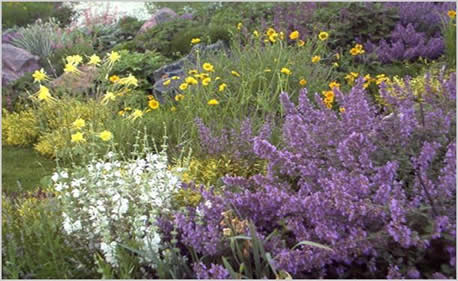|
Landscaping
Xeriscaping
Xeriscaping*: The practice of promoting water conservation through specific landscaping techniques.

One way to reduce water waste and promote a healthy garden or yard is xeriscaping. Depending on the region, homeowners use up to 30-60% of their water outside. That's clean, drinkable water, and often a large portion of it is wasted on inefficient watering methods and systems.
Quick Tips to Water-friendly Landscaping
Planning: Identify sunny and shady areas and slope. Group plants with similar water and sun/shade needs together.
Improving Soil: A healthy soil absorbs and retains water better, so add organic material, like leaves & ash.
Efficient irrigation: Use a drip system or soaker hose to water deeply and infrequently. Time it for periods of lowest evaporation, like night or early morning.
Turf Alternatives: Grassy areas should be kept to a minimum size & alternatives considered.
Mulch, MULCH, MULCH: Two to four inches of mulch will conserve water & help keep the soil cool. Mulch also suppresses weeds & aids decomposition.
Maintain: Even a xeriscaped yard needs attention. Prune yearly & keep the watering system functioning optimally.
General: Waterwise gardening tips.
Planting Native Plants
Native plants typically require far less water than non-native species as they are well-adapted to the local climate. Listed below are some good examples of native plants that make a good addition to any yard or garden. If you are unsure of a plant's watering or sun/shade needs, consult with your local nursery.
- Manzanita
- Up to 20ft tall, either evergreen shrub or small tree
- Extremely drought tolerant
- Attractive flowers and berries
- Silver Wormwood (mugwort, sagebrush)
- Strong, pleasant aroma
- Often attracts butterlies
- Penstemon
- Deciduous or semi-evergreen perennials
- Variable height
- Multiple flower colors
- Mountain Dogwood
- Dense and fine-grained wood
- Deciduous tree or shrub
- Characteristic white flowers
- Redberry
- 3-6ft tall evergreen shrub
- Native to California
- Western Redbud
- Phlox
- Colorful flowers, usually pale blue, biolet, pink, bright red, or white.
- Thrive in diverse habitats, from alpine tundra to woodland and prarie.
Click here to learn more about finding native plants specifically suited to your area.
Resources for Additional Ideas & Information
Funding for this project comes from: California Environmental Protection Agency State Water Resources Control Board
Funding for this project has been provided in full or in part through an agreement with the State Water Resource Control Board. The contents of this document do not necessarily reflect the views and policies of the State Water Resources Control Board, nor does mention of the trade names or commercial products constitute endorsement or recommendation for use.
(Gov. Code. 7550; 40 CFR 31.20)
Funding support to create more user-friendly, detailed information in order to facilitate better water resources management and public awareness also was generously provided by the State of California Department of Water Resources (DWR), from the Safe Drinking Water, Water Quality and Supply, Flood Control, River and Coastal Protection Bond Act of 2006 via Humboldt County on behalf of the seven county North Coast Resource Partnership region under the North Cost Integrated Regional Water Management Plan (NCIRWMP) Proposition 84 Planning Grant.
*“Xeriscape” is a registered trademark of the Denver Water Board of Denver, Colorado, an organization dedicated to water conservation. | 